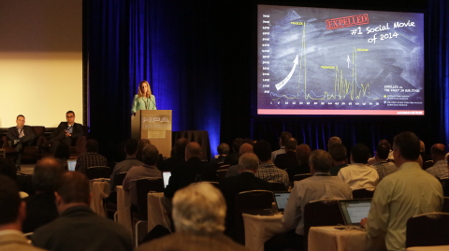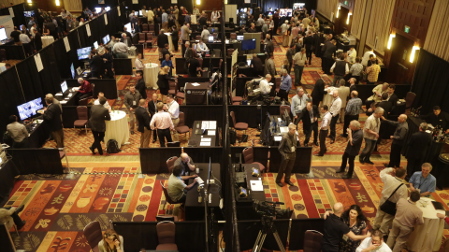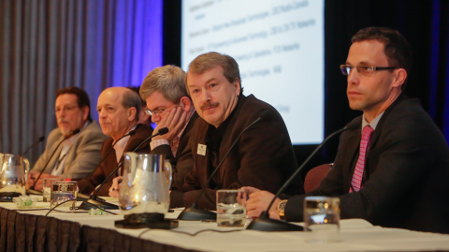HPA Tech Retreat to Focus on HDR, Changes in Broadcast
INDIAN WELLS, CALIF.—The 2016 HPA Tech Retreat, Feb. 15–19 at the Hyatt Regency in Indian Wells, Calif., will be the first since HPA merged with SMPTE last year. Although SMPTE Executive Director Barbara Lange was announced as the HPA executive director last year, the merger, according to HPA Tech Retreat “program maestro” Mark Schubin, was completed in October and the name—Hollywood Post Alliance—was changed to “Hollywood Professional Alliance.” The event, which accommodates approximately 650 people, has been sold out for the last four years.

The annual HPA Tech Retreat is one of the premier events covering the latest in television and film technology.
Other than that, the HPA Tech Retreat will be unchanged in its focus on the technical issues facing Hollywood production and post production executives, artists and companies. Schubin reports that this year has seen a record number of submissions—152—for panels, which he attributes in part to the fact that the SMPTE Advanced TV Conference couldn’t accommodate all of the proposed panels.
HIGH ON HDR
One of the dominant themes at the 2016 Retreat is high dynamic range, says Schubin. “I was one of the first champions of HDR at the Tech Retreat, presenting studies showing it gives the ‘biggest bang for the bit,’” he said. “People watching it see a more significant improvement than with higher frame rate or more pixels.” Renown Color Scientist Charles Poynton, who conducts an annual seminar at the retreat, will devote a half-day to practical applications of HDR, and Annie Chang, vice president of post-production technology at The Walt Disney Company, is organizing a three-hour session on the topic for Thursday morning.
“With the experience I’ve had so far with HDR, I feel there’s a lot of misinformation, from shooting through distribution,” notes Chang. “What I’m going to attempt to do in this session is dispel myths and educate, relying on people who have actually been doing it. The devil is in the details.”
The session begins with OneRiver Media Owner/Filmmaker Marco Solorio who will provide an HDR primer. Next, an International Cinematographers Guild-sponsored panel will focus on HDR production workflows, with DIT/colorist Stephen Latty, director of photography Eduardo Mayen and Canon USA senior fellow Larry Thorpe discussing the impact of HDR on the choices that cinematographers make, the additional tasks that DITs perform, the challenge of on-set monitoring, the details of HDR color science, and other relevant topics. A panel organized by Colorfront and moderated by “British Cinematographer” magazine Editor Ron Prince will focus on HDR post production, as well as how to deal with legacy SDR content. Colorfront CTO Bill Feightner, who will sit on the panel, reports that panelists from several different post-production facilities will focus on their companies’ solutions for handling HDR.

The show’s popular “demo room” has been rebranded the “Innovation Zone.”
Chang says the three-hour session will also focus on the two major video encoding functions currently used for HDR: Hybrid Log Gamma and PQ, to discuss pros and cons, as well as a section on consumer displays. “HDR is a big topic,” she says. “The questions that arise should be compelling. I want to create a balanced viewpoint so people can make their own decisions.”
The popular “demo room” which focuses on new technologies and services has been rebranded the “Innovation Zone” and will serve as a showcase of collaboration among exhibiting vendors.
BROADCASTERS PANEL
The broadcasters panel has been rated highly by HPA Tech Retreat attendees, says moderator Matthew Goldman, senior vice president of technology, TV and media strategy at Ericsson and an executive vice president on the SMPTE Board. This year’s panel will address the transition from HD to Ultra HD among other topics.
“The transition from analog to digital and SD to HD was pretty exciting back in the early 2000s,” says Goldman. “I think the transition to Ultra HD is happening at a more rapid pace. Now we’re going from a digital broadcaster-centric plant to an all-IP infrastructure. It’s broadcast vying with non-traditional competitors: media streaming and over-the-top.

The broadcasters panel is one of the most popular sessions of the five-day event.
“With the transition from HD to UHD, spectrum allocation, the mobility of video and the conversion of industry-specific infrastructure to IP, the word ‘TV’ doesn’t mean what it used to,” he adds. “It used to be a communal viewing screen. Now, it’s a ‘viewing experience.’”
ATSC 3.0, he notes, is a chance for broadcasters to stay relevant, as the industry transforms. The panel will include a mix of experts from broadcasting and media streaming, and the format will focus on questions from the audience. “There are no taboo topics,” he says. “The hour-long panel, according to Goldman, will be “a whirlwind of interactive conversation.” “I encourage panelists and the audience to react and respond,” he adds.
IN REVIEW
The rest of the HPA Tech Retreat will be no less interesting, with panels on creative frame rates, NASA’s deep space photography, the cloud, virtual reality, big data, OLED displays, ACES 1.0, and remote live production, among other topics. In his annual “Technology Year in Review” on Wednesday morning, Schubin plans to describe a new development with regard to frame rate. “High frame rate is an advanced TV feature,” he notes. “But people don’t see in frames. In increasing frame rate, we are trying to solve the problem of low frame rate. But what if we could produce imagery the way our eyes see it—sensitive to change? It turns out a lab in Germany has been working on a sensor that captures moving images the way our eyes work, and we’ll see images from that retinal sensor.”
Disney will make a couple of interesting appearances at the Tech Retreat, first with a presentation by Disney Research Zürich, and lastly with the annual “Post-Retreat Treat.” Presented by The Walt Disney Company’s manager/library film archivist Jayson Wall, attendees will have a chance to learn about and enjoy “The History, Production, and Restoration of Dateline Disneyland,” the live coast-to-coast broadcast of the opening of the park in 1955.
For more information on the HPA Tech Retreat, visit www.hpaonline.com.
Get the TV Tech Newsletter
The professional video industry's #1 source for news, trends and product and tech information. Sign up below.
